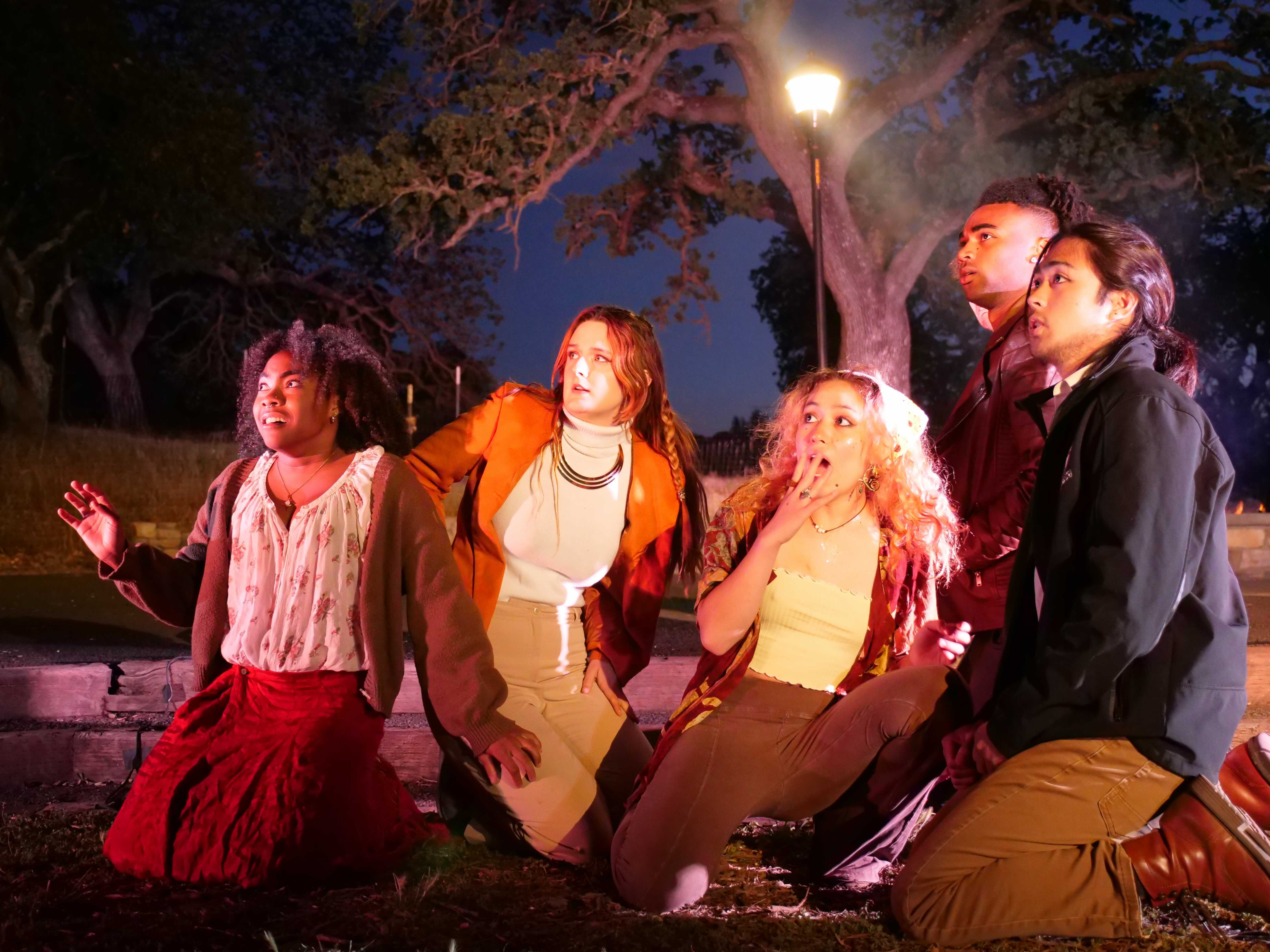On Saturday night, the Lake Lagunita fire pit was transformed into a kitchen in the forest behind an old farmhouse, where the characters of “Solstice Party” celebrated the longest day of the year as the sun slowly set in the background.
“Solstice Party,” written by Susan Soon He Stanton, follows a group of friends who travel to upstate New York to celebrate the summer solstice. Former “frat bro” Andrew (Matthew Canlas ’23) brings his younger, yoga-instructor girlfriend Pipi (Skya Theobald ’24) to meet his college friends: investment banker-turned-farmgirl Jo Ann (Regan Lavin ’22), her chef-turned-farmer husband Dominique (Chance Staples ’25) and lesbian Trish (Eryn Perkins ’25), who is missing her wife. The awkward but enthusiastic fixer-upper ranch hand Stan (Danny Ritz ’23) is an outcast; over the course of the play, he bonds over existence at the margin with Pipi, who doesn’t quite belong with the friend group.
“Solstice Party” succeeded in breaking boundaries through its creative set choices and strong actors, but the show’s confusing plot and technical challenges were performance weaknesses.
Director Chloe Chow’s ’23 decision to adapt the Stanford Theater Lab’s spring production to the outdoor space richly complemented the play’s too-often-relatable feeling of being left out: joining an already tight-knit friend group or trying to coalesce when you’ve grown out of each other. The audience sat on picnic blankets and chairs in front of the fire pit, physically placing the viewers inside the action. The real sunset and emerging nocturnal hums of the lake provided a grounded backdrop for the production’s experimental take, immersing the audience in a unique viewing experience.
The complex blocking — the choreography of character placement and actions — creatively utilized the vast outdoor stage. As the characters walked around Lake Lagunita to go fishing, brushing past Stanford members on their daily runs, it felt as if these characters naturally emerged from somewhere within our campus — that they were real, grounded people who could’ve easily existed here.
The embedded tension that unfolds over the course of the play is its central focus, exaggerated by sinister tones and an unexpected — although arguably gratuitous — cliffhanger ending. Chow paid large attention to building up nuanced character dynamics; the relationships between old friends and social outcasts of this tight-knit but flawed friend group inquire about the nature of community at times of uncertainty. Given that this was only the second time this play has ever been performed, Chow wonderfully adapted the semi-thriller “Solstice Party” into a play that focused on community.
The cast added significant depth to the relationships of these flawed individuals, employing great performances to bring out Stanton’s intended theme of self-delusion. My favorite scene was when the characters gathered around, half-drunk in a circle, to ask questions and revisit their past. It was here that Jo Ann admitted: “When I’m happy, I don’t wanna be told anything; when I’m sad — everything.”
As the sun set halfway through the play, battery-powered lighting, designed by D Fukunaga ’25, became a sinister character of its own, hinting toward the grim twist at the end of the show.
The technical side of this production was very impressive given the logistical difficulties of operating outdoors. Lighting and sound devices had to be set up and taken down every night during technical rehearsals and final performances, according to assistant director M Seng ’25 and producer Tyler Newman ’25.
Acting-wise, Ritz’s portrayal of the quirky, energetic Stan and his unique vocal performance shone in this production in the few moments when the characters sang songs around the bonfire. Ritz’s versatility to perform more serious, darker themes towards the end of the show solidified him as one of the actor-singers to watch out for on campus.
In contrast to Stan’s charming personality, Lavin’s performance effectively portrayed her character’s unlikeability; Jo Ann’s judgmental-insecure complex allowed the audience to reflect on the times they have been or encountered a Jo Ann in their lives.
The entrance of Ashley (Sarah Lee ’23) in the final arc of the show took “Solstice Party” into an unexpected, supernatural twist, with plots related to a cult being introduced and unfolding rapidly. When compounded by a “was this all a dream?”-type ending, many audience members left the firepit confused. The cult theme felt like a throwaway plot, especially compared to the play’s rich emphasis on each character’s secret dark past. While the earlier part of the show proved to be a great character study on how flawed humans interact, the underdeveloped twist felt unwarranted and distracting to the inspection of humanity that was already being slowly developed and interrogated.
Although the show’s ambition to transform the outdoor space into a stage is commendable, the acoustics made it challenging to experience both the actors’ performances and the already confusing plot. The vast stage and outdoor setting placed the actors further away, and the temporary sound system didn’t quite catch the little inflections in line delivery, which would have provided even more depth to the show.
While the pairing of slow-burn, slice-of-life writing and contrived twist left me more confused than curious, Chow and the cast opened a window into the fragile landscape of relationships and the undercurrent of longing to be honest with oneself. Stanford Theater Lab’s charming and technically impressive production set a high bar for the possibility of site-specific performance.
Editor’s Note: This article is a review and contains subjective opinions, thoughts and critiques.
